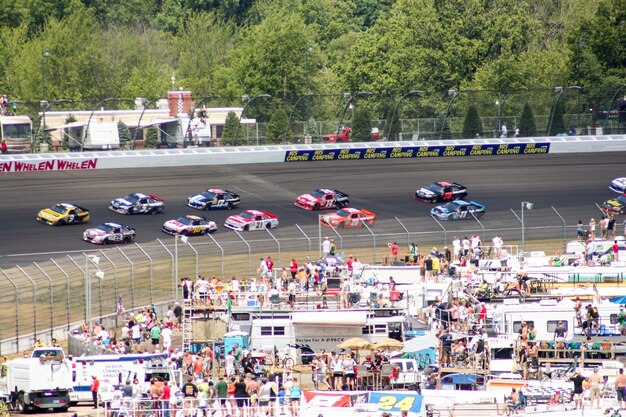NASCAR’s Next-Gen Car: Reshaping the Sport in 2025

The NASCAR Next Gen car, introduced in 2022, is poised to continue its transformative impact on the sport by 2025, offering enhanced performance, cost efficiency for teams, and a more competitive racing environment that aims to captivate both long-time fans and new audiences with closer racing and greater vehicle parity.
The landscape of professional stock car racing has been in constant evolution, but few shifts have been as profound as the introduction of NASCAR’s Next Gen car. For fans and teams alike, understanding how this innovative vehicle is changing the sport promises to reshape the competitive fabric and spectacle of racing in 2025 and beyond.
The Genesis of a Revolution: Understanding the Next Gen Car’s Core
The Next Gen car, officially debuted in the 2022 season, wasn’t merely an update; it was a fundamental redesign. Born from years of research and development, its inception aimed to address several critical areas: escalating costs, safety, relevance to production cars, and, crucially, to improve the on-track product. By 2025, its influence will have solidified, marking a distinct era in NASCAR history.
This vehicle represents a monumental leap, moving away from a traditional, somewhat antiquated design philosophy towards a more contemporary, purpose-built race car. Its modular construction and standardized components are at the heart of this transformation, allowing for greater control over performance parameters and fostering a more level playing field among teams.
Design Innovations and Their Purpose
From the chassis up, nearly every aspect of the Next Gen car was re-evaluated. The independent rear suspension, a significant departure, allows for better handling characteristics, particularly on road courses and short tracks. This change alone has profound implications for how engineers set up the cars and how drivers approach corners, potentially leading to varied strategies and more dynamic racing.
- Standardized Components: Many parts, from the chassis to the wheels and tires, are now single-source supplied, reducing the competitive advantage gained through extensive R&D budgets.
- Aerodynamic Enhancements: The car features an improved underwing and diffuser, designed to generate more downforce from the ground rather than solely relying on the car’s body.
- Five-Lug Wheel Evolution: A single, center-locking lug nut replaces the traditional five-lug pattern, streamlining pit stops and adding another layer of strategic complexity.
The composite body, mimicking production car aesthetics more closely, not only offers increased durability but also makes repairs more straightforward and less costly. This focus on component commonality and repairability is a direct response to the financial pressures teams faced with the previous generation of cars.
Safety and Future Relevance
Safety has always been paramount in NASCAR, and the Next Gen car incorporates advanced energy-absorbing materials and design elements to better protect drivers during impacts. The modular frame allows for more controlled deformation, dissipating crash forces more effectively. Beyond the immediate safety improvements, the car’s architecture also positions NASCAR to be more relevant to future automotive technology, including potential hybrid powertrains, ensuring the sport evolves with the industry.
In essence, the Next Gen car is NASCAR’s strategic move to modernize, equalize, and future-proof the sport. By 2025, its impact will be deeply woven into the fabric of competition, driving narratives of triumph and adaptation across the racing landscape.
Impact on Competition: Parity and Performance Dynamics
One of the primary goals of the Next Gen car was to increase competitive parity within the sport. Historically, larger, wealthier teams with extensive R&D budgets often dominated, making it challenging for smaller outfits to compete consistently. The standardized components and design features of the Next Gen car are specifically engineered to reduce this disparity, aiming to level the playing field.
By 2025, we are already witnessing the fruits of these efforts. The racing has become tighter, with more lead changes and a greater variety of winners. This isn’t to say that team execution and driver skill are no longer paramount – quite the opposite. With the cars being more similar in their baseline performance, even marginal gains from team strategy, pit stop execution, and driver prowess become amplified, making for enthralling battles on track.
Closer Racing and Strategic Depth
The aerodynamic package of the Next Gen car, particularly its reliance on underbody downforce, has significantly altered racing dynamics. Drivers report that the cars are more sensitive to dirty air, meaning leading cars don’t create as much of a wake to hinder following cars. This can lead to more opportunities for overtakes, especially on intermediate tracks, which have historically been criticized for processional racing.
The removal of critical aero dependencies from the car’s body panels also means teams can be more aggressive physically, knowing that minor contact won’t necessarily destroy the car’s aero balance. This encourages closer quarter racing and adds a thrilling element of unpredictability.
- Driver Skill Emphasis: With less dependence on custom-built components, individual driving talent comes even more to the forefront.
- Setup Nuances: Teams focus intently on maximizing the standardized components through meticulous setup adjustments, making every tenth gained in the garage critical.
- Reduced Blowouts: The single lug nut and larger wheel assembly contribute to fewer tire failures during races, allowing for harder driving.
The independent rear suspension also fundamentally changes how cars handle bumps and turns, particularly on road courses. This technical shift demands a different driving style and a new approach to car setup, opening the door for specialists to shine and challenging even the most seasoned veterans to adapt.
While the initial rollout of any new car can present challenges, by 2025, the Next Gen car has undoubtedly fostered a more competitive and unpredictable racing environment. The enhanced parity ensures that more teams and drivers have a legitimate shot at victory each weekend, keeping fans engaged and the championships fiercely contested.
Team Operations and Economics: A New Financial Landscape
Prior to the Next Gen car, NASCAR team budgets were spiraling upwards, driven by the need for continuous research and development to gain a competitive edge. The fabrication of custom parts, the endless testing, and the arms race of engineering talent made it increasingly difficult for team owners to turn a profit or even break even. The Next Gen car was specifically designed to rein in these escalating costs, fundamentally altering the economic landscape of the sport.
By 2025, the effects of this economic shift are clearly visible. With many components now supplied by a single source, teams no longer need to spend exorbitant amounts on designing and manufacturing unique parts. This has shifted resources from fabrication to refinement – focusing on car setup, pit strategy, and driver development.
Cost Reduction and Investment Shift
The most immediate and profound impact has been on the balance sheets of racing organizations. Teams are spending less on manufacturing and more on operational efficiency. This reallocation of funds allows for better financial stability, attracting new investors and potentially enabling new teams to enter the sport without prohibitively high initial capital outlays.
Smaller teams, in particular, have benefited immensely. Before the Next Gen car, they often struggled to keep pace with the R&D budgets of NASCAR’s giants. Now, with a more controlled cost environment, they can compete more effectively, making the sport more accessible and diverse. This isn’t just about saving money; it’s about restructuring where that money is best spent to achieve on-track success.

- Reduced R&D Costs: Less internal fabrication means lower expenses on machinery, personnel, and prototyping.
- Supply Chain Efficiency: Centralized component sourcing streamlines logistics and inventory for teams.
- Greater Sustainability: Lower operational costs contribute to the long-term viability of teams and the sport itself.
This economic restructuring extends beyond just the parts. The standardized chassis and bodies mean that teams also save on repair costs, as damaged panels are easier and cheaper to replace. This durability means cars can often recover from minor incidents, reducing the number of total write-offs and extending the useful life of a race car.
Attracting New Talent and Sponsorship
The improved financial health of teams has a ripple effect. It makes ownership a more attractive proposition for potential investors, broadening the pool of capital available to the sport. Furthermore, sustained financial stability makes teams more appealing to high-caliber talent, from engineers to pit crew members, ensuring the sport continues to attract the best and brightest.
Sponsors, too, benefit from a more financially sound sport with a more predictable cost structure. They are more likely to invest in an environment where their marketing dollars can generate a greater return on investment, knowing that teams are operating efficiently. By 2025, the Next Gen car has undeniably made NASCAR a more economically sustainable and attractive proposition for all stakeholders involved.
Fan Engagement and Spectacle Implications
At its heart, professional racing is about entertainment, and the Next Gen car was designed with the fan experience firmly in mind. NASCAR understood that to retain its loyal base and attract new audiences, the on-track product had to be compelling and unpredictable. The changes inherent in the Next Gen car aim to deliver just that, by fostering closer competition, more challenging driving, and a look that resonates with modern automotive design.
By 2025, fans are experiencing a rejuvenated sport. The narrative of “who is going to win?” feels more open-ended each week, moving beyond the dominance of a select few teams that sometimes characterized eras of the previous generation car. This unpredictability is a powerful draw for casual and dedicated fans alike, making every race a must-watch event.
On-Track Excitement and Race Outcomes
The technical changes, such as the independent rear suspension and improved aerodynamics, have led to observable differences on the track. Road course racing has seen a significant boost, with cars handling more like true performance machines. This has led to more intense battles on these technical circuits, providing a fresh dimension to the season calendar.
On ovals, particularly the intermediate tracks, the car’s characteristics have promoted more side-by-side racing and a greater ability to make passes. The increased durability also means fewer races are neutralized by minor incidents, allowing for longer green flag runs and more strategic pit stop cycles. This translates directly to more action for the spectators.

- Visual Appeal: The sleeker, more pronounced design of the Next Gen car offers a visual connection to everyday sports cars, appealing particularly to younger demographics.
- Enhanced Sound: While not a design change, the absence of side exhausts on the Next Gen car allows the roaring engines to be heard more clearly, intensifying the auditory experience for fans.
- Closer Competition: The inherent parity leads to more drivers and teams genuinely contending for wins, ensuring more compelling storylines throughout the season.
The impact of this closer racing is not just anecdotal; statistics reflect an increase in lead changes, tighter finishes, and a broader distribution of race winners. This dynamic keeps fans on the edge of their seats, knowing that any driver on any given Sunday truly has a shot at victory.
Bridging Generations and Attracting New Fans
The modern aesthetic of the Next Gen car also plays a crucial role in attracting new, younger fans. It looks more like a contemporary sports car, making it more relatable to individuals who might not have grown up with traditional stock car racing. This visual relevance, combined with the exciting on-track product, is vital for the long-term growth and sustainability of the sport.
Furthermore, the technological advancements within the car provide new talking points for broadcasts and social media, allowing for deeper dives into the technical aspects of racing. This can engage tech-savvy audiences and provide another layer of understanding for those interested in the engineering marvels behind the speed. By 2025, the Next Gen car has firmly established itself as a key driver of fan engagement, promising a vibrant future for NASCAR’s loyal base and its expanding audience.
Challenges and Adaptations: The Road Ahead
No significant overhaul comes without its share of hurdles, and the Next Gen car’s introduction has presented a unique set of challenges for teams, drivers, and NASCAR as an organization. While by 2025 many of the initial kinks have been ironed out, the ongoing process of adaptation continues to define the competitive landscape. Understanding these challenges is key to appreciating the resilience and ingenuity of those involved in the sport.
One of the most prominent initial challenges was simply learning a completely new vehicle. Teams accustomed to generations of similar car designs suddenly had to rethink everything from chassis setup to pit stop choreography. This steep learning curve tested the engineering prowess and adaptability of every organization.
Technical Adjustments and Setbacks
The advent of standardized parts, while economically beneficial, initially led to some quality control issues from single-source suppliers. These issues, though largely resolved by 2025, occasionally caused frustration and led to unexpected failures. NASCAR and its suppliers have had to work diligently to ensure consistent quality and availability of components.
Drivers, too, had to adapt their techniques. The independent rear suspension and new tire compounds meant changes in how they approached corners, managed tire wear, and even how they reacted to contact. The learning process involved feedback loops between drivers, engineers, and crew chiefs, constantly refining setups and driving lines tailored to the Next Gen car’s unique characteristics.
- Initial Supply Chain Hurdles: Ensuring consistent quality and timely delivery of single-source components was a significant undertaking.
- Driver Adaptation: Racers had to unlearn old habits and develop new driving styles for the unique handling of the Next Gen car.
- Crash Safety Evaluation: Ongoing analysis of crash data to further enhance driver protection within the new car’s design.
Furthermore, the car’s rigidity, while intended to improve safety by better absorbing impacts, initially presented some challenges regarding driver comfort post-impact. NASCAR has been proactive in studying incident data and implementing refinements to mitigate these concerns, demonstrating a commitment to continuous improvement in safety.
Strategic Evolution in the Garages
The shift to standardized parts also meant that traditional ways of gaining an advantage—through proprietary R&D on components—were largely eliminated. Teams have had to pivot their competitive strategies towards meticulous setup adjustments, simulation work, and optimizing every aspect of pit road performance. This has fostered a new kind of engineering competition, focusing on data analysis and precision.
By 2025, the teams that have thrived are typically those quickest to adapt and innovate within the new ruleset. This period of adaptation has showcased the ingenuity of crew chiefs and engineers, who are constantly pushing the boundaries of what’s possible within the Next Gen car’s framework, ensuring NASCAR remains at the forefront of automotive sport.
Looking Ahead to 2025 and Beyond: The Legacy of Next Gen
As we move deeper into 2025, the NASCAR Next Gen car is no longer a novelty; it is the established foundation of the sport. Its lasting legacy will be defined not just by the immediate changes it wrought but by how it positions NASCAR for sustained growth, innovation, and relevance in the broader automotive landscape. The car represents a strategic pivot, aiming to ensure the sport remains vibrant and engaging for future generations.
The long-term vision behind the Next Gen car extends beyond just competition and cost control. It’s about creating a platform that is adaptable to future technologies, particularly as the automotive industry rapidly evolves towards electrification and sustainable fuels. The car’s modular design offers a flexibility that was previously unattainable, allowing for easier integration of new components and powerplants.
Sustainability and Future Technology Integration
One of the most significant aspects of the Next Gen car’s design is its potential for future powertrain integration. While currently utilizing an internal combustion engine, the architecture is conducive to incorporating hybrid systems or even fully electric powertrains should NASCAR choose to move in that direction. This foresight ensures NASCAR can align itself with global automotive trends and maintain relevance.
The increased efficiency and durability of the car also contribute to a form of sustainability – less waste from destroyed cars, optimized supply chains, and a more financially sustainable model for teams. These elements, while perhaps not as immediately exciting as on-track action, are critical for the long-term health of the sport.
- Platform for Innovation: The modular design makes it easier to integrate new technologies, like advanced safety features or alternative powertrains.
- Global Relevance: By adopting more road-car relevant technology, NASCAR gains appeal on an international stage.
- Enhanced Fan Experience: Continuous refinements will likely improve the racing product, keeping fans more engaged.
By 2025, discussions around potential future engines, including hybrid solutions, are becoming more tangible. The Next Gen car provides the perfect testbed for such advancements, allowing NASCAR to lead in high-performance automotive technology while maintaining the core elements that fans love.
Growth and Global Appeal
The refined aesthetics and closer racing fostered by the Next Gen car are also designed to broaden NASCAR’s appeal globally. A car that looks more like a modern sports car is inherently more relatable to an international audience, potentially opening doors to new markets and fan bases beyond North America. This is crucial as top-tier motorsports increasingly compete on a global stage.
The implementation of the Next Gen car is more than an engineering project; it is a strategic repositioning of NASCAR itself. It’s a testament to the sport’s commitment to evolving, adapting, and innovating to secure its future. By 2025, the car has not simply changed the sport; it has reset its trajectory, paving the way for decades more of thrilling competition and technological advancement.
| Key Aspect | Brief Impact |
|---|---|
| 🏁 Competition Parity | Enhanced competition with closer racing and diverse winners due to standardized parts. |
| 💰 Economic Efficiency | Reduced team costs by limiting R&D, making the sport more financially sustainable. |
| 🛠️ Technological Leap | Modern design, independent suspension, and future-proof architecture for new tech. |
| 📈 Fan Engagement | More exciting races, visually appealing cars, and a broader appeal to new audiences. |
Frequently Asked Questions About the Next Gen Car
The NASCAR Next Gen car made its highly anticipated official debut at the start of the 2022 Cup Series season. Its introduction marked a significant turning point for the sport, following years of development and testing aimed at modernizing various aspects of stock car racing, from competitive parity to team economics.
The Next Gen car incorporates a more robust chassis and redesigned crumple zones to absorb and dissipate crash energy more effectively. It features enhanced cockpit protection and improved seating positions for better driver safety. Continuous data analysis from on-track incidents further refines these safety measures as the car evolves.
A pivotal change was the switch from a solid rear axle to an independent rear suspension. This modification significantly improves the car’s handling characteristics, especially on road courses and short tracks, allowing for more dynamic cornering and potentially diverse setup strategies by teams vying for an advantage.
Yes, one of the primary objectives of the Next Gen car was to increase competitive parity. By standardizing many components, it reduces the advantage once gained through large-scale R&D, focusing competition on driver skill, team strategy, and precise car setup. This has led to closer racing and more varied race winners.
The Next Gen car has significantly reduced team operational costs by centralizing the supply of many parts and lowering the need for extensive in-house manufacturing. This economic efficiency aims to make team ownership more financially viable, potentially attracting new investors and fostering greater sustainability for the sport.
Conclusion
The introduction and continuous evolution of the NASCAR Next Gen car mark a pivotal moment in the sport’s history. By 2025, its transformative impact is undeniable, reshaping not only the on-track product with tighter competition and more exhilarating races but also fundamentally altering the economic model for teams. This innovative vehicle has successfully addressed long-standing challenges, driving NASCAR towards a more sustainable and exciting future. As the sport continues to adapt and refine its premier machine, the Next Gen car stands as a testament to NASCAR’s commitment to innovation, fan engagement, and maintaining its position at the pinnacle of American motorsports.





